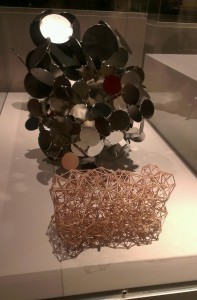Earlier today, Dan Klyn retweeted a piece by Cennydd Bowles entitled ‘Void and matter’. It’s an interesting spin on the age old question of ‘what is information architecture?’, and more specifically, how the practice differs from other types of User Experience Design, such as Interaction Design.
Back in 2008, I had no idea what information architecture was. I started to attend the BBC’s IA team meetings, thanks to the generous invite of Karen Loasby, despite me not being a member of that team just yet, and there was plenty of talk of ‘defining the damn thing’.
More recently, Abby Covert, amongst several others, has done stirling work to reinvigorate the practice and consideration of IA. I’m loathe to open up the definition can of worms, but I started thinking about it in response to Cennydd’s piece, and I came up with this:
Information Architecture is the design of structures and/or systems that communicate meaning.
By which I mean — almost everything in the world conveys meaning of some sort, whether it is intended to, or not. Hence apophenia (23). But when you do design things in order to communicate some kind of meaning or idea, you are designing an information architecture. This, of course, sounds similar to ‘information design’, I suppose — though I’d argue the latter is perhaps less focused on structures and systems.
If you ever find yourself looking at a piece of web design (let’s narrow it down to that for now), and you wonder — but what does it actually mean, what is it trying to communicate? Then you’re thinking with an information architecture hat on. And, more importantly, to not consider the meaning, or indeed the perception, or what exactly someone is meant to take away from your design, is a huge failing. Which is why I can’t understand UX processes that don’t seriously make time for IA — and probably why IAs who do care so passionately about the meaning of things do get so easily drawn into ‘defining the damn thing’.
Anyway — to Cennydd’s piece directly. What I very much like is the distinction between designing “things that are smaller” than the designer, and “things that are larger”. It reminds me of the old adage that you should always design your product, system, platform or service to be able to fit into a larger system. Don’t just think of your work as the be all and end all — allow it to enable things you’ve not even thought of.
Cennydd also makes an interesting metaphor in “designing the void” versus “designing the matter”. But here’s where I’d like to stress something — designing the matter is absolutely information architecture as well. This isn’t a criticism of the piece — there are no definitive ‘correct’ answers here — I’d just like to offer my spin on something I feel really needs to be highlighted, else IAs (and other UX folk) feel they’re off the hook.
The examples that Cennydd gives — “the tools people manipulate. Materials with properties and responses”. Now, more than ever, information architects need to get involved here. Because the matter we’re creating on the Web is made almost entirely of information structures.
Think about APIs, think about URIs for Things, think about domain driven design with its classes and properties — those are the tools we make available to manipulate, these are the things that we grapple with on the Web.
Information Architects need to be involved in designing the matter on the Web. Interaction Designers need to understand APIs, URIs for resources, linked data (yes, I know), REST and so on. Because that is the raw material we’re dealing with here — networked, interactive information. Designing the matter is the real Web design. And whatever your UX leaning, understanding that is key to harnessing the wonderful medium we have at our disposal.
